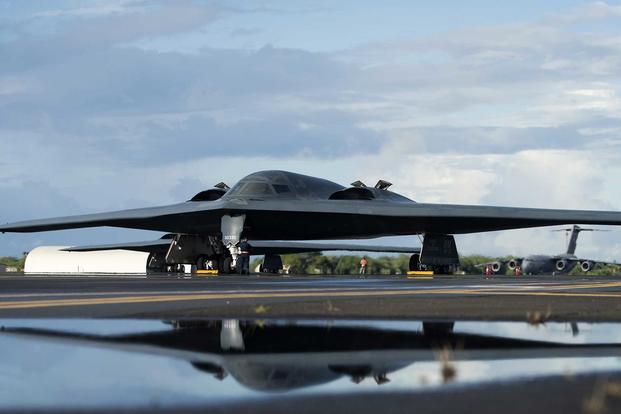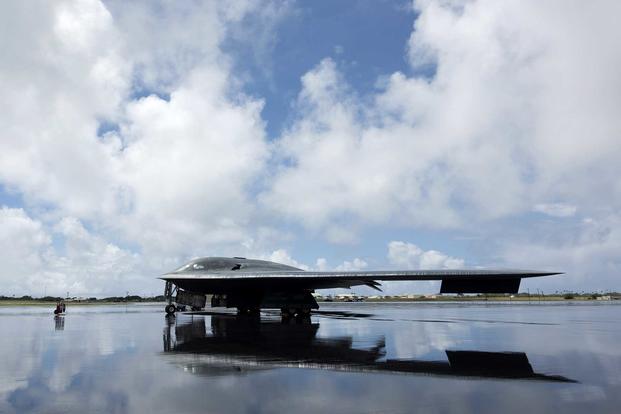B-2 Spirit bombers recently wrapped up their first-ever rotation to Joint Base Pearl Harbor-Hickam, Hawaii, and executed missions with their F-22 Raptor stealth fighter counterpart, giving pilots a sense of how the two aircraft would pair in a high-threat environment, according to the Air Force.
Three of the bombers and approximately 200 airmen from Whiteman Air Force Base, Missouri, deployed for the six-week rotation as part of U.S. Strategic Command's Bomber Task Force mission, the service said in an Oct. 4 news release.
"The B-2 Spirit's first deployment to [Hickam] highlights its strategic flexibility to project power from anywhere in the world," Maj. Gen. Stephen Williams, director of air and cyberspace operations, Pacific Air Forces, said in the release. "The B-2s conducted routine air operations and integrated capabilities with key regional partners, which helped ensure a free and open Indo-Pacific."
The training focused on integrating with F-22s from the 199th Fighter Squadron, 154th Wing, under the Hawaii Air National Guard. F-22s escorted the heavy bombers in simulated exercises, providing extra situational awareness during the mission, officials said.
Related content:
- Chinese Destroyer Imperils Navy ship with 'Unsafe' Move in South China Sea
- B-2 Stealth Bomber Returns to Pacific to Deter North Korea
- Air Force Sees Unique Challenges in Deploying Stealth Fighters
For example, the F-22's sensors have the ability to identify other aircraft -- down to the airframe -- and detect surface-to-air missiles and relay their existence to other friendly forces while remaining stealthy on radar.
"The Bomber Task Force is a total-force integration deployment," said Lt. Col. Nicholas Adcock, commander of the 393rd Bomb Squadron, part of Air Force Global Strike Command. "Our active-duty and Guard members worked seamlessly together with their counterparts here in Hawaii to determine the best way for the B-2 to operate from this location in the future."
Airmen supporting the operations also practiced hot-pit refueling and loading inert BDU-50 bombs in the B-2's bomb bay, the Air Force said.
Hot-pit refueling means an aircraft's engines keep running on the flight line while it takes on fuel. The technique, which reduces maintenance hours and turnaround time to get an aircraft airborne, has become more prevalent, especially for aircraft such as the C-130 Hercules, which makes multiple trips in a day.
A B-2 practiced hot-pit refueling Sept. 14 at Wake Island, an atoll in the mid-Pacific nearly 2,500 miles from Hawaii and just north of the Marshall Islands, the service said.
Without citing specific numbers, airmen loaded BDU-50s -- a practice version of the general-purpose Mk 82 -- on the Hickam flight line to rehearse how quickly they could ready weapons.
"This weapons load is the first stepping stone to loading live munitions from this location," said Master Sgt. Nicholas Lewis, the 393rd Aircraft Maintenance Unit weapons section chief. "Furthermore, it provides pilots and load crews valuable training necessary to accomplish future [Bomber Task Force] missions."
The exercises concluded Sept. 27, the Air Force said.
Last year, a B-2 flew to the Pacific to demonstrate the U.S.' commitment to partners and allies while North Korea conducted missile tests. Its presence at the time marked the first for the B-2 -- capable of carrying both conventional and nuclear weapons -- in the theater since a trio of the bombers wrapped up training exercises in early 2017 with the Australian Air Force.
-- Oriana Pawlyk can be reached at oriana.pawlyk@military.com. Follow her on Twitter at @Oriana0214.











